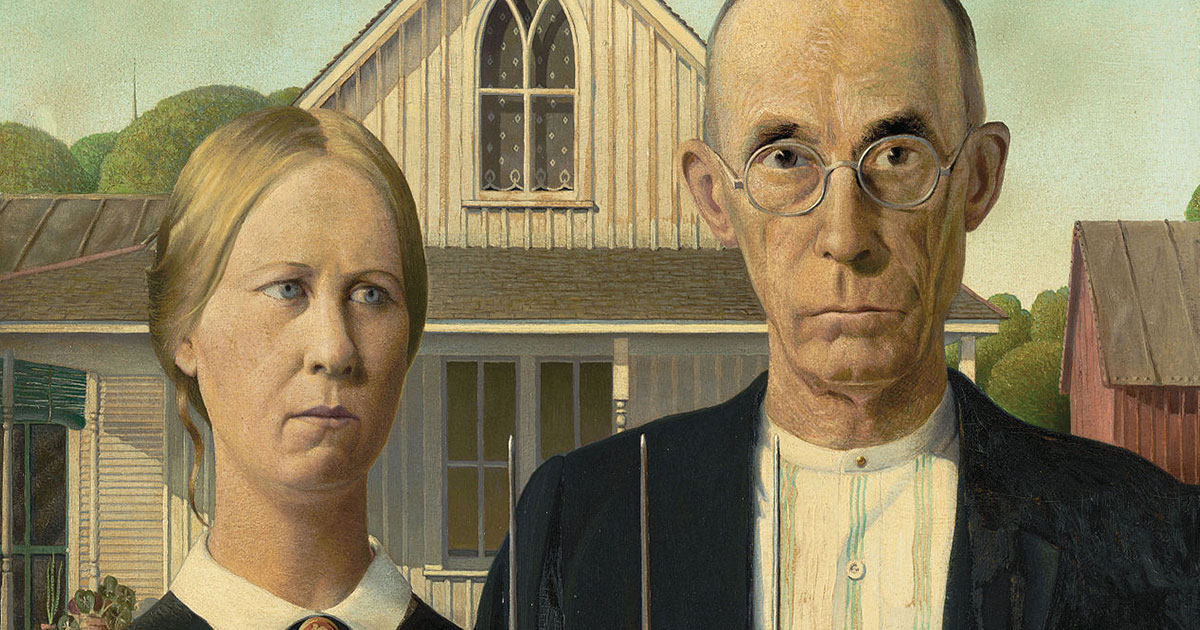Every artist creates with intentions, cultivating an untold story behind the painting. Every brush stroke and each shade of color used to unfold the image often has a hidden message, a written word on the canvas. Whether they’re inspirational or charismatic, it’s time to slow down to read these invisible memoirs.
American Gothic by Grant Wood
In 1930, American artist Grant Wood, was ecstatic winning $300 for his oil painting, “American Gothic,” in the Art Institute of Chicago. A simple glance shows a portrait of a man, gripping a pitchfork, and a woman standing in front of a farmhouse. So, how did Wood become inspired?
A young artist encouraged Wood to take a casual drive with him during his visit to Eldon, Iowa. On the drive, Wood’s attention was immediately captured by a farmhouse that held large, lonely windows (Dibble House). After Wood gained the consent of the homeowners, he began painting the Gothic-style house along with two individuals that he imagined would perfectly fit its living style. While most people assume the man and woman are husband and wife, Wood intended to portray a daughter and father. For the daughter, Wood imagines his very own sister. For the father, Wood painted his dentist, who had a prominent role in his life as he had quite the sweet tooth.
Today, his painting is known to be the Mona Lisa of American art. It became a staple representation of the Regionalism movement and the Great Depression in America as it focused on authentic American subjects.
Mona Lisa by Leonardo Da Vinci
There is no need for an introduction for this famous Renaissance painter with his iconic “Mona Lisa” displayed in the Louvre Museum and “Last Supper” in Santa Maria Delle Grazie. However, many people misunderstand the intentions behind the painting of the “Mona Lisa” by Leonardo Da Vinci. The beautiful lady with a mysterious smile is believed to be Lisa del Giocondo, the wife of a very wealthy Florentine merchant of the era. Da Vinci created the painting shortly after Mona Lisa and her husband had their second child. However, many critics dare to believe that the Mona Lisa is disguised as Da Vinci himself! Although the truth behind Da Vinci’s intentions remains to be an unresolved mystery, the painting itself holds immense value.
Did you know that it once went missing for 28 months? In 1911, former Italian employee of the Louvre, Vincenzo Peruggia, locked himself in a storeroom on the night of August 20th. The following morning, Peruggia hid the painting under his coat as he walked home to store the treasured painting in a suitcase under his bed in a Parisian boarding house. It remained there for 28 months until Peruggia finally went back to his hometown on the banks of Lake Maggiore, Italy. Peruggia claimed that the painting historically belonged to Italy, not France. Later, he was placed on trial for being ‘mentally disabled’ and incarcerated for about eight months.
The Scream by Edvard Munch
In 1893, Edvard Munch painted “The Scream,” which today has been referenced in almost everything from Home Alone to countless parodies. From a glance, the painting inspires expressionistic colors that are swirling the sky, leading the viewer’s eye to the main subject: a mysterious person clasping their face as they appear to be screaming in anguish on a road. So, why is the main subject screaming?
Scholars believe “The Scream” to be an honest glimpse into the troubling life of Edvard Munch, as he dealt with great anxiety. The painting was thoughtfully based on a personal experience that Munch detailed in a diary entry in 1892. He described his evening as a casual walk with two friends to admire the vivid sunset when he became overwhelmed with exhaustion and experienced a violent wave of anxiety. During Munch’s panic attack, he felt as if his two friends had left him alone and he was consumed in a chorus of screams.
Artists tend to express their memorable experiences and raw emotions through their paintings. Some are shoveling deep into their own thoughts or even opening a pictorial path for what they might imagine to be a better life. The question is not, “Is there a story?” The better question is, “How do I discover their story?”


















